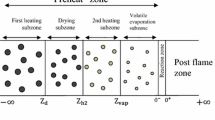Abstract
This paper presents the effects of the temperature difference between gas and particle, different Lewis numbers, and heat loss from the walls in the structure of premixed flames propagation in a combustible system containing uniformly distributed volatile fuel particles in an oxidizing gas mixture. It is assumed that the fuel particles vaporize first to yield a gaseous fuel, which is oxidized in a gas phase. The analysis is performed in the asymptotic limit, where the value of the characteristic Zeldovich number is large. The structure of the flame is composed of a preheat zone, reaction zone, and convection zone. The governing equations and required boundary conditions are applied in each zone, and an analytical method is used for solving these equations. The obtained results illustrate the effects of the above parameters on the variations of the dimensionless temperature, particle mass friction, flame temperature, and burning velocity for gas and particle.
Similar content being viewed by others
References
R. K. Eckhoff, Dust explosion in the process industries, Oxford: Butterworth, Heinemann, (1997).
B. Kaesche-Krischer and J. Zehr, Untersuchungenan Staubkuft-Flammen, Z. Phys. Chemie, 14 (1958) 384–387.
W. E. Mason and M. J. G. Wilson, Laminar flames of lycopodium dust in air, Combustion and Flame, 11 (1967) 195–200.
H. D. Ross, Reducing Adhesion and Agglomeration within a Cloud of Combustible Particles, NASA Technical Memorandum 100902. Springfield, VA: National Technical Information Service (1988).
C. Proust, Experimental Determination of the Maximum Flame Temperatures and of the Laminar Burning Velocities for Some Combustible Dust-Air Mixtures, Proceedings of the Fifth International Colloquium on Dust Explosions, Pultusk, Poland. (1993) 161–184.
K. Seshardi, A. L. Berlad and V. Tangirala, The Structure of Premixed Particle-Cloud Flames, Combustion and Flame, 89 (1992) 333–342.
D. Bradley, Z. Chen and S. El-Sherif, Structure of Laminar Premixed Carbon-Methane-Air Flames and Ultrafine Coal Combustion, Combustion and Flame, 96 (1994) 80–96.
C. Proust and B. Veyssiere, Fundamental properties of flames propagating in starch dust-air mixtures, Combustion Science and Technology, 62 (1988) 149–172.
B. Veyssiere, Development and propagation regimes of dust explosions, Powder Technology, 71 (1992) 171–180.
O.-S. Han, M. Yashima, T. Matsuda, H. Matsui, A. Miyake and T. Ogawa, Behavior of flame propagating through lycopodium dust clouds in a vertical duct, Journal of Loss Prevention in the Process Industries, 13(6) (2000) 449–457.
C. Proust, Flame propagation and combustion in some dust-air mixtures, Journal of Loss Prevention in the Process Industries, 19 (2006) 89–100.
C. Proust, A few fundamental aspects about ignition and flame propagation in dust clouds, Journal of Loss Prevention in the Process Industries, 19 (2006) 104–120.
I. Han and K.Y. Huh, Roles of displacement speed on evolution of flame surface density for different turbulent intensities and Lewis numbers in turbulent premixed combustion, Combustion and Flame, 152 (2008) 194–205.
S. Chakraborty, A. Mukhopadhyay and S. Sen, Interaction of Lewis number and heat loss effects for a laminar premixed flame propagating in a channel, International Journal of Thermal Sciences, 47(1) (2008) 84–92.
Z. Chen, M.P. Burke and Y. Ju, Effects of Lewis number and ignition energy on the determination of laminar flame speed using propagating spherical flames, Proceedings of the Combustion Institute, 32 (2009) 1253–1260.
Author information
Authors and Affiliations
Corresponding author
Additional information
This paper was recommended for publication in revised form by Associate Editor Dongshin Shin
M. Bidabadi received his B.S degree in Mechanical Engineering from the Iran University of Science and Technology, and the M.S and Ph.D degrees from the University of Sharif, Iran and McGill University, Canada respectively. He has been a Faculty Member at Iran University of Science and Technology. His Ph.D research involved an experimental and analytical study of laminar dust flame propagation. He’s core research interests are dust flame propagation mechanisms, development of a new experimental apparatus to produce laminar, and optimization of the smoke wind tunnel. These interests have led to publish several research papers in the dust combustion. His recent study includes combustion, wind tunnel and gas dynamics.
A. Rahbari received his B.S degree in Mechanical Engineering from the Azad University in Sep. 2005, and the M.S degrees in Mechanical Engineering from the Sharif University of Technology in Sep. 2007. Now, He is a PhD candidate in Mechanical Engineering in Iran University of Science and Technology. His Ph.D research involved the analytical study of laminar dust flame propagation. His research focuses on the dust combustion, HCCI Engine, micro-combustors, heat transfer and boundary layer transition. These interests have led to publish several research papers in the mentioned subjects.
Rights and permissions
About this article
Cite this article
Bidabadi, M., Rahbari, A. Novel analytical model for predicting the combustion characteristics of premixed flame propagation in lycopodium dust particles. J Mech Sci Technol 23, 2417–2423 (2009). https://doi.org/10.1007/s12206-009-0710-z
Received:
Revised:
Accepted:
Published:
Issue Date:
DOI: https://doi.org/10.1007/s12206-009-0710-z



